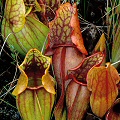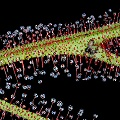Q: What do you mean by complex names like Drosera binata var. multifida f. extrema?

S. purpurea
subsp. purpurea

D. binata var. multifida
f. extrema
A: Sometimes a population of plants defies the simple classifications provided by mere
genus and species. It may be that across the range of the species, variant populations occur which seem significantly
different from the usual form of the plant. If the variant populations are sufficiently different, they may merit
being treated as separate species. But if the differences are not so large, the population may be defined as being
a different "subspecies" (which is contacted to "subsp.").
For example, the pitcher
plant Sarracenia purpurea grows in Canada and all along the eastern edge of the
USA. It did not take botanists long to see that the plants in Canada and the northeastern USA
were different from the plants in the southeastern USA. So they named the southeastern
plant Sarracenia purpurea subsp. venosa.
When they did this, the rest of the plants---the ones in Canada and the
northeastern USA---were automatically given the name
Sarracenia purpurea subsp. purpurea.
Notice the subspecies name for this type is just a repeat of the species name.
(I can imagine some of the more nerdy of you shooting your hands upwards into the air in protest. Yes, I know that in
this particular case the actual story was more complicated than that. I know about Reveal's publications. Just sit
back down! I talk about that mess on a different FAQ page.)
Subspecies is not the only subcategory you
may see. There are also "varieties". For example, some varieties of
Drosera binata (binata=fork-leafed)
produce leaves with many (multi) branches,
hence D. binata var. multifida. There is not a general agreement
among scientists as to when you should use subspecific or varietal designation
to indicate a unique population of plants. A common perspective, though, is
that "subspecies" should be used to describe populations that do
not live in the same place, like the northern and southern subspecies of
Sarracenia purpurea. Meanwhile, "variety" should be used
when the plant sub-types live in the same area, as is the case with the various kinds of
Sarracenia flava.
Lastly, there is a designation called a "form". A form is a
tiny variation on the normal plant. A form is usually not considered to be
very important from an evolutionary perspective. For example, recall our
friend D. binata var. multifida?
A rare form exists which has a great number
(more than around sixteen) leaf tips. It is called
D. binata var. multifida f. extrema.
You see there are very careful rules to Latin names, and you cannot just
invent them whenever you like. Botanical Latin names
must be first published in a scientific journal before they are considered
valid. People informally coining new pseudo-Latin plant
names (such as "alba" for a plant because it has atypical, white flowers)
have caused huge amounts of trouble for horticulturists
and scientists alike. And to complete the ironic circle of my discussion, it turns out that while
the name D. binata var. multifida f. extrema
is in common use, it has never been properly described and is, as a result, something called a
nomen nudum!
Page citations: Cheek, M. 1994; Greuter, et al. 2000; Slack, A. 1979; personal observation.